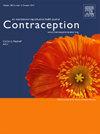置换避孕植入物与长期使用避孕植入物的出血模式比较
IF 2.8
2区 医学
Q1 OBSTETRICS & GYNECOLOGY
引用次数: 0
摘要
目标我们旨在比较在三年内更换避孕植入物的人与在三年后延长使用植入物的人的出血天数和出血天数以及满意度。方法我们进行了一项前瞻性队列研究。参与者报告了在预约植入前 30 天的出血天数和点滴出血天数,决定更换(更换者)或延长(延长者)使用,然后报告了更换后 30 天的出血天数和点滴出血天数。参与者还记录了他们对出血和/或点滴出血量的满意度。我们使用 Wilcoxon 秩和检验来比较组间未调整的中位数差异,并使用多变量中位数(量级)回归来调整共变量。结果在 52 名参与者中,更换或延长使用植入物前 30 天或更换或延长使用植入物后 30 天,两组之间在仅出血天数(0 对 0,p=1.00)或任何出血天数(0 对 0,p=0.39)方面没有显著差异。决定更换植入物的患者在预约前 30 天的点滴出血天数较多,但差异无统计学意义(2 对 1,P=0.06)。我们发现,30 天前和 30 天后对出血/点状出血模式表示满意的天数中位数差异无统计学意义(0 vs. -1, p=0.85)。结论无论是种植体置换者还是延长者,在置换或延长种植体 30 天前后的出血情况都没有发生显著变化。这些数据可以帮助临床医生在患者决定保留或更换避孕植入物三年时,就出血模式为患者提供咨询。本文章由计算机程序翻译,如有差异,请以英文原文为准。
COMPARISON OF BLEEDING PATTERNS WITH REPLACEMENT VERSUS EXTENDED USE OF THE CONTRACEPTIVE IMPLANT
Objectives
We aimed to compare bleeding days and spotting days and satisfaction among individuals who replaced their contraceptive implant at three years versus those who extended use of the implant past three years.
Methods
We conducted a prospective cohort study. Participants reported number of bleeding and spotting days for 30 days prior to their implant appointment, decided to replace (replacers) or extend (extenders) use, and then reported number of bleeding and spotting days for 30 days after. Participants also recorded their satisfaction with the amount of bleeding and/or spotting. We used Wilcoxon Rank Sum tests to compare unadjusted median differences between groups and multivariable median (quantile) regression to adjust for co-variates.
Results
Among 52 participants, there was no significant difference between the two groups 30 days before or 30 days after replacing or extending use of the implant for spotting only days (0 vs 0, p=1.00) or any bleeding days (0 vs. 0, p=0.39). There were more spotting days 30 days prior to the appointment among those who decided to replace their implant, however the difference was not statistically significant (2 vs. 1, p=0.06). We found no statistically significant differences in median number of days reporting satisfaction with bleeding/spotting patterns from before and after 30 days (0 vs. -1, p=0.85).
Conclusions
Neither implant replacers nor extenders experienced significant changes in bleeding 30 days before or after replacing or extending. This data can help clinicians counsel patients regarding bleeding patterns when they are deciding to keep or replace their contraceptive implant at three years.
求助全文
通过发布文献求助,成功后即可免费获取论文全文。
去求助
来源期刊

Contraception
医学-妇产科学
CiteScore
4.70
自引率
17.20%
发文量
211
审稿时长
69 days
期刊介绍:
Contraception has an open access mirror journal Contraception: X, sharing the same aims and scope, editorial team, submission system and rigorous peer review.
The journal Contraception wishes to advance reproductive health through the rapid publication of the best and most interesting new scholarship regarding contraception and related fields such as abortion. The journal welcomes manuscripts from investigators working in the laboratory, clinical and social sciences, as well as public health and health professions education.
 求助内容:
求助内容: 应助结果提醒方式:
应助结果提醒方式:


